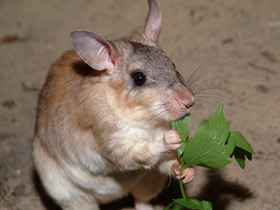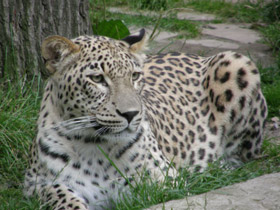Amoy's tiger, South China tiger or Xiamen tiger (Panthera tigris amoyensis)
Habitat
The Amoy's tiger, South China tiger or Xiamen tiger (Panthera tigris amoyensis) is the most endangered of all tiger subspecies. It is also the smallest subspecies in existence. In the late 19th and 20th centuries, its range covered southern central China and is now limited to Fujian, Guangdong, Jiangxi and Hunan provinces. The Latin name was given to the subspecies after the island of Xiamen (Amoy), where the beast managed to migrate from mainland China.
The habitat of the Chinese tiger is deciduous forest with dense undergrowth and a mixture of conifers, at altitudes of 1000-3000 m, seashores, mangroves and river valleys.
Appearance
Adult Panthera tigris amoyensis, unlike the Amur, is relatively small in size. Males weigh between 127 and 177 kilograms and females between 100 and 118 kilograms. The distinguishing feature of Chinese tigers is their tusks, which are up to 4 centimetres long. Their paws are very powerful, with a kick of up to 500 kilograms, enough to kill a buffalo with a single blow.
Nutrition and behaviour
Panthera tigris amoyensis form family pairs only during the breeding season, the rest of the time they live alone. These animals are good swimmers and can reach speeds of up to 56 km/h; they have excellent hearing and eyesight. Tigers make their dens in dense thickets, in rock crevices and under fallen tree trunks. They usually follow the same routes, marking their territory with urine; they strip the bark from some trees along the way.
Chinese tigers hunt at any time of the day or night. They feed mainly on deer and wild pigs. Primates, porcupines, reptiles, birds and fish are not uncommon prey. Tigers attack larger prey from behind, snapping their necks with their paws or digging their fangs into their throats.
Reproduction
Female Panthera tigris amoyensis incubates her cubs for about three months. The cubs are born in winter. A litter consists of 2 to 4 blind cubs. They are fed on mother's milk until 4-5 months of age, and become accustomed to meat after two months. Young animals hunt actively from the age of one year, and at the age of two they are ready to lead an independent life.
Population numbers and threats
Not so long ago, the population of Panthera tigris amoyensis exceeded 4,000. The beast inhabited hard-to-reach areas of China, was good at hiding from humans, could attack livestock, and there were cases of cannibalism. Active hunting did not begin until the 1940s, was commercial in nature and quickly led to the almost total extermination of the population. Even a shot Panthera tigris amoyensis fetched fabulous money for poachers, who were willing to risk life and limb for it. The organs of Panthera tigris amoyensis were used to make oriental remedies and the skin was made into a carpet, an exotic handbag or a souvenir.
The Chinese authorities banned shooting the predator in 1977. The last case of poaching dates back to 1994.
Active exploitation of wildlife by humans, the displacement of Panthera tigris amoyensis to uninhabitable areas, the reduction of feeding grounds and the pollution of water sources by industrial and agricultural run-off have also contributed to a critical reduction in numbers of the subspecies.
There are currently no more than 20-25 individuals of Chinese tigers left in the wild, and there is only indirect evidence of their presence in certain areas. The data are based on eyewitness reports of Panthera tigris amoyensis in protected areas, isolated tracks found on mountain trails and tree markings. The animals have not yet been captured by CCTV cameras operating in China's five provinces.
Around 70 raptors are in captivity worldwide, most of them living in Chinese zoos. The animals in China are closely related, are the offspring of only six individuals and do not breed well.
In 2000, Save Chinas Tigers, a non-governmental charitable foundation, was established with the primary goal of restoring the numbers of these predators and returning them to the wild. Its offices are located in the United States, the United Kingdom and Hong Kong. The Chinese government is actively involved in the foundation's programme and has supported it since 2008.











































